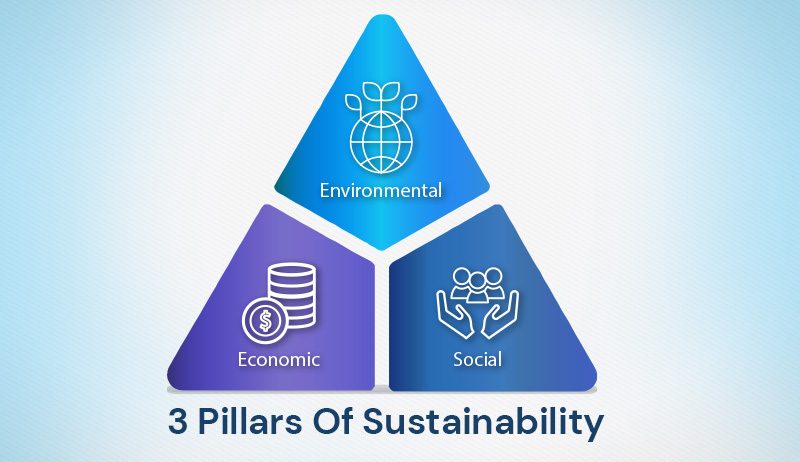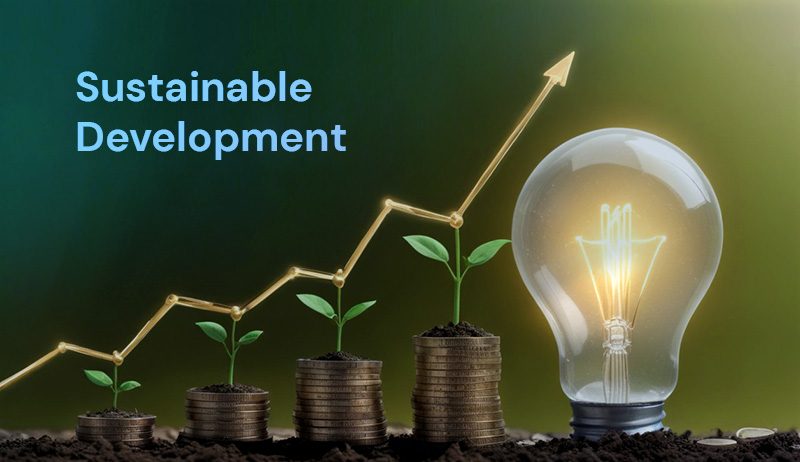Sustainable practices help the environment, support economic growth, and strengthen communities.
While sustainability might seem challenging for businesses, many companies worldwide have found long-term benefits by focusing on the 3 pillars of sustainability. So, why are they important?
Sustainability is more than just being green. It involves looking at social, economic, and environmental impacts.
The three pillars of sustainability aim to create a balance where people and nature can live together to meet the needs of both present and future generations.
This policy has led to business strategies that benefit the economy, protect the environment, and promote social fairness. For example, green buildings save energy and money over time.
These business strategies show how sustainability can help businesses succeed while protecting natural resources and supporting communities.
What are the 3 Pillars of Sustainability?
Corporate sustainability means running a business that creates long-term value for shareholders, employees, customers, and society by using responsible environmental, social, and economic strategies.
Let’s talk about the three pillars now!
Environmental Protection (Environment Pillar)
Natural resources are essential for the economy because they provide the materials required for manufacturing and production. The environment supports many aspects of modern life, such as transportation and food.
The concept of sustainable development, introduced in the 1980s, means meeting today’s needs while hindering future generations from meeting theirs.
This involves ensuring clean air and water, conserving resources, and restoring ecosystems. The United Nations has set 17 Sustainable Development Goals to encourage global action.
Facilities managers, real estate owners, contractors, and engineers must protect the environment. In many places, this duty is enforced by law through federal or state regulations.
Businesses must include measures like wastewater treatment and emissions reduction in their operations. Following these regulations and adopting extra sustainability practices can improve efficiency and profitability.
Economic Viability (Economic Pillar)
Economic viability means an economy’s ability to maintain production levels over time. It includes job creation, social well-being, eco-friendly market practices, sustainability costs, government support for sustainable business practices, and the overall health of people and the environment.
Practically, economic viability is also about having successful, enduring businesses. Due to its fair business model, the company recovered and grew more substantial.
A crucial part of economic viability is thinking about long-term effects. If a company focuses only on short-term profits, it might use up natural resources, harming its prospects.
Wise business leaders understand that their long-term success depends on these resources and create business models that promote sustainability.
Social Equity (Social Pillar)
Social sustainability and equity focus on the long-term health and well-being of social systems, whether global, national, local or within an organization.
This includes human health, education, environmental justice, and maintaining a sustainable balance for everyone involved. Paying attention to these factors helps people and the environment thrive together, supporting economic and environmental goals.
Businesses can ensure long-term sustainability by incorporating best practices into their supply chains, manufacturing processes, and working conditions and supporting their communities.
Businesses that allow pollution endangers public health or exploit workers with low wages or forced labor risk failing.
Implementing sustainable practices that provide fair wages, safety measures, and social support helps reduce conflict and poverty, leading to long-term success for the business and the community.
These pillars evaluate a company’s sustainability and allow us to determine how close an organization is to sustainability.
As a result, a sustainable company maintains its previous development level at the end of its evaluation or promotes activities to improve the level in all three areas.
The three pillars of sustainability must interact harmoniously because sustainability cannot exist without them. Each pillar demonstrates a context in which sustainability is applied while relying on others to support itself.

The Intersection of the 3 Principles
The three principles of sustainability are connected and depend on each other. Achieving true sustainability means taking a comprehensive approach that considers the interactions between the environment, society, and the economy.
When these principles work together, they create a strong foundation for lasting positive change.
For example, businesses that use environmentally sustainable practices can reduce their impact on the environment, create green jobs, and support local communities, enhancing social sustainability.
Investing in renewable energy and adopting circular economy practices, which also benefit the environment, can improve economic sustainability.
Understanding Corporate Sustainability
Corporate sustainability practices are often grouped under ESG, which stands for environmental, social, and governance practices. Companies use ESG to reduce their environmental impact and achieve goals that benefit society. For investors, this aligns with SRI or socially responsible investing.
Sustainability is about meeting today’s needs without harming future generations’ ability to meet theirs. Companies practice sustainability by using fewer limited resources or finding alternatives that have less environmental impact.
The three main pillars of sustainability are environmental care, social responsibility, and economic cooperation, also known as people, planet, and profit.
The Impact of Sustainability
The main question for investors and executives is whether sustainability benefits a company. When done right, it can be very advantageous. Sustainability strategies often draw from successful business practices.
Sustainability gives companies a larger purpose and new goals to aim for. It helps them renew their focus on efficiency, sustainable growth, and shareholder value.
A public sustainability strategy can also bring intangible benefits, like goodwill and a better reputation. If it helps a company get credit for positive actions it is already taking, it’s beneficial.
For some companies, sustainability is a way to organize various efforts under one concept and gain public recognition. For others, it means addressing practices that might harm their operations.
Sustainability and a public commitment to it might become as crucial as compliance for publicly traded companies.
How to Implement Corporate Sustainability

In today’s world, aiming for corporate sustainability can be beneficial for a company, its employees, customers, shareholders, the community, and the planet. When thinking about sustainability, consider the three pillars.
Here are some simple steps to help you plan a corporate sustainability program or project:
- Understand the Basics: Learn about the principles of people, planet, purpose, and profit, and plan to integrate them into your company culture.
- Evaluate Your Business: Look at your current business needs, goals, and opportunities. Identify which sustainability goals fit your priorities.
- Create a Mission Statement: Develop a mission statement that aligns with your sustainability goals to guide your company’s direction.
- Get Leadership Support: Ensure top leaders and managers are on board with your sustainability plans.
- Engage Stakeholders: Seek feedback from shareholders, employees, suppliers, partners, customers, and the community. Make sure they understand the benefits of sustainable practices.
- Set Strategies: Develop strategies to achieve your sustainability goals.
- Track Progress: Choose a method for tracking changes and results and assign staff to manage this process. Consider offering performance incentives to meet sustainability-related goals.
Why Apply These Pillars Within Your Company?
Social Pillar: Ensure Employee Well-Being
Promoting social values within your company helps ensure the well-being of your employees. When employees are happy at work, they are more likely to stay longer and contribute positively to the company’s dynamic.
Ethical actions and good practices create a better society, making the social pillar crucial for sustainable development.
Economic Pillar: Optimize Your Budget
Adopting responsible production methods, such as recycling, reducing waste, and using renewable materials, can lower expenses while promoting sustainable consumption.
Efficient resource management and reusing waste in new production lines can optimize budgets and resources, making the economic pillar vital for achieving success in sustainable development.
Environmental Pillar: Improve Your CSR Strategy
Incorporating environmental goals into your company’s management is critical for corporate social responsibility (CSR).
While legally required for companies with over 500 employees, a strong CSR strategy is beneficial for all businesses, enhancing eco-friendly practices and improving brand image.
The environmental pillar is essential for creating a sustainable world and combating climate change.
What is Sustainability Reporting, and Why is it Important?

Sustainability reporting is when companies share their progress in protecting the environment, treating people fairly, and managing their operations responsibly.
They tell stakeholders about their efforts and their effects on sustainability, like how much they pollute, what social programs they’re involved in, and how they’re governed.
This information usually appears in yearly reports or separate sustainability reports that mix financial and non-financial details.
It’s crucial for a few reasons:
Transparency: It lets everyone know how well a company is doing with sustainability, giving insight into their practices and impacts.
Accountability: By reporting on sustainability, companies are held responsible for what they’re doing and are encouraged to get better at it over time.
Engaging Stakeholders: It helps companies connect with stakeholders like investors, customers, and communities by showing them what they’re doing to be sustainable.
Managing Risks: Sustainability reporting helps companies spot and handle risks related to climate change or social issues, which can affect their long-term performance.
Gaining an Edge: Companies with good sustainability performance can stand out from the competition, attracting investors, customers, and employees who care about ethical practices.
For more sustainable information, keep an eye on Cyanergy.







